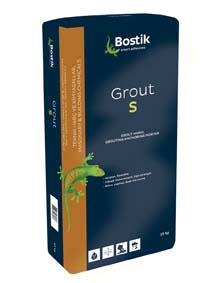
| Model | Grout S Bostik |
| D max (mm) | 2 |
| Applicable Thickness (mm) | 30 |
| Dry Unit Volume Weight (kg / l) | 1,5 ± 0,2 |
| Wet Unit Volume Weight (kg / l) | 2,2 ± 0,2 |
| Pot Life (min) | ~ 60 |
| Curing Time (hour) | ~ 24 |
| Compressive strength (28 days) (N/mm2) | 60 ~ 90 |
| Flexural Strength (28 days) (N/mm2) | ≥ 6 |
| Adhesion Strengt h (concrete) (28 days) (N/mm2) | ≥ 2 |
| Water Mixing Ratio (for 25 kg dry mortar) | 3,0 – 3,5 l |
| Environment temperature for application | Between +5°C and +35°C |
| Colour | Grey |
| Packaging (kg) | 25 |
Features:
- Highly fluid (ideal for densely reinforced and narrow moulded areas)
- Long applicability period x Self-settles due to its fluidity and easily gets the shape of any mould, allows gap-free concrete pouring, penetrates into the cracks and gaps easily
- For fastening the industrial machines and joint elements of the machines to the floor, and filling the edges and lower parts with concrete
- For concreting the joints of steel elements and concrete elements
- For making all kind of anchorage, assembly and concrete repair; and filling piers
- For installing railways, placing lids of sewages and water channels
- For fastening bridge parapets, traffic lights, billboards to the floor and fastening the reinforcements while enhancing girder-columns
- High first and second compressive strengths x Adheres to steel very strongly, absorbs the tension
- Resistant to water, constant wetness, frost and heavy weather conditions
- No shrinkage
- Fireproof, therefore it is used safely in the areas where epoxy use is risky
Areas of applications:
- Interior and exterior
- In concrete fastening and tasks of reinforced concrete
- In multi-purpose moulded anchorage tasks x In crane rails and piers x In the joints of roads and bridges
This is a mineral and cement based, in compliance with TS EN 1504-3 R4 class, normal curing grouting mortar that is prepared with reinforcement of high quality granulometric sand, cement and high quality chemical additives. It is used in the tasks of fastening and mounting various elements such as steel construction, equipments and machine foundations both interior and exterior. It has a very strong adhesion feature that’s first and second compressive strengths are high. The product is flexible and fluid and it can be either applied manually or pumped by means of a machine in liquid state. It features expansion quality, doesn’t undergo shrinkage and self-settles thanks to its high level of fluidity.
Preparation of the substrate: The application surface should be dry, clean, strong and free from dirt and other adherence reducing materials as well as crack-free, stable and strong enough to bear burden. When necessary, application surface should be cleaned with sanding, pressure water or pressure air spraying method. Before the anchorage, the surface should be wetted sufficiently, however water accumulation on the surface should be avoided.
Application: Water (2/3 of the amount stated on the chart above) at normal environment temperature is poured into a clean container. Then, some dry mortar is added in the container which is full of water and mixed with a suitable mixing machine or device without stopping. It is mixed until a smooth and homogenous mixture is obtained. Some amount of water, which should not exceed the amount stated on the technical data chart, can be added in the mortar prepared in order to obtain the desired consistency. After 2 minutes’ aging period, the mortar is mixed gently again. The mortar, which is now ready to apply and highly fluid, should be applied within maximum one hour. In order to prevent air bubble formation in the mortar, or if an anchorage is to be carried out without mould, the application should start from only one corner or edge, and the air inside should be released. The poured mortar should be mixed and checked with a tool when necessary and air bubbles should be removed.
After application: The exposed and newly applied surfaces should be protected against fast drying for minimum 3 days. To avoid it, keeping the surface humid by using wide folios and humid jute sacks would be enough.
Coverage: Approx. 18 – 22 kg/m2 for 10 mm thickness.
* The coverage amounts are theoretical and it is recommended to do coverage-controlled sample application before treatment.